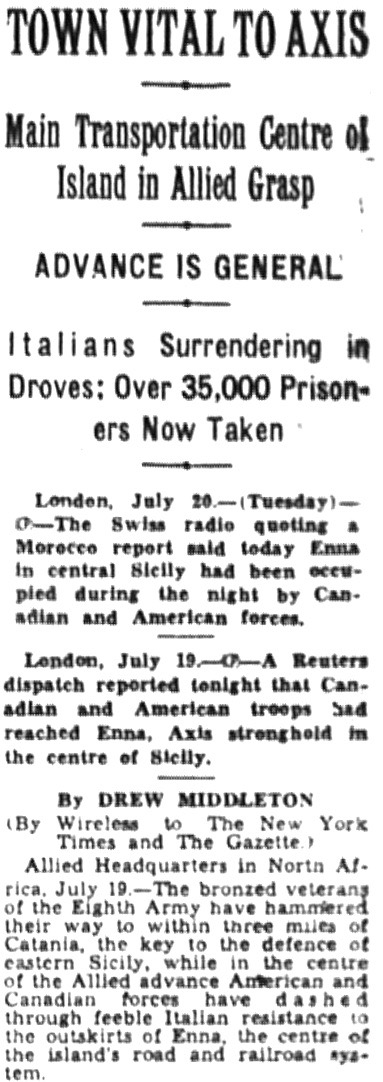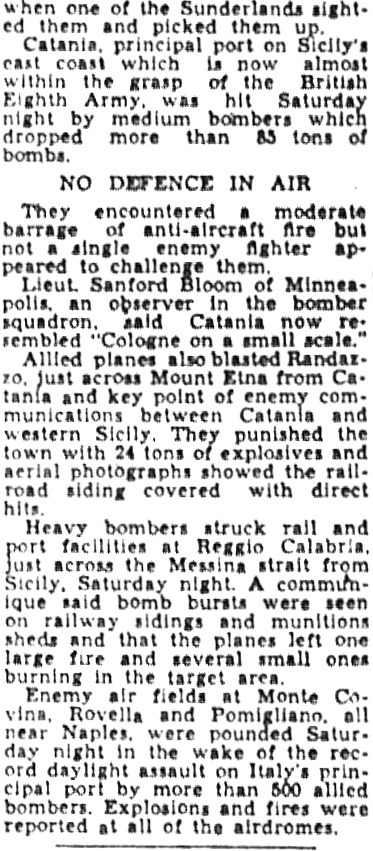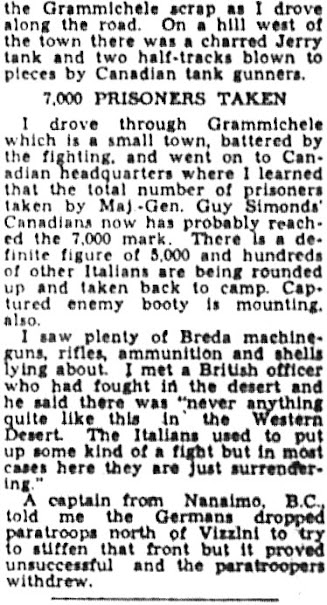Rome Targets Blasted, Monty Still a Favourite to Troops,
Gazette Correspondent Describes Eastern Coast of Sicily
Correspondent Lionel S. B. Shapiro, The (Montreal) Gazette, July 1943
Photo 21545, Photogr. Dolan, Album 61 from Can. Army Film Unit
with 1st Canadian Tank Brigade and Auxiliary Troops in 'The Med'
Shapiro penned the above book re the invasion of Sicily not
very long after returning from the Mediterranean Sea. GH
The above book is one of my favourites among several about Sicily and Italy. Shapiro was on or near the beaches in GEORGE Sector and may have accompanied Canadian troops to the toe of Italy's boot in September, with Canadian landing craft (80th flotilla) manned by Canadians sailors, including my father, leading the way.
Shapiro's Gazette articles - quite lengthy, and under his own byline - will soon start to outweigh Ross Munro's (!) in future posts on this site.
I was able to locate a few more photographs by CAFU (Canadian Army Film Unit) of Shapiro and the Sicilian coast during the first week or two of the invasion (HUSKY) and readers will spot a few as this post progresses.
And now for today's news!
FYI - Enna, mentioned above, is a city at the centre of the island's road and railroad network.
And, of course, Rome is the centre of attention as well, because of its numerous "freight yards and key railroad lines" and "the presence of Germans and their satellites":
Yes, this is the same fellow as pictured in the top photo - on a Cook's tour - minus the sunglasses, binoculars and sensible Bermuda shorts:
Please note that Shapiro mentions his "Cook's tour" was only possible four days after the invasion of Sicily began. Below are a few words about the first three days by members of the Canadian Navy who transported troops and material of war to shores on the eastern coast:
Simcoe newspaper interview from Dec. 1943, sent to me by Joe Watson's
grand-daughter. Joe is in the middle of the top-of-blog photo. GH
My father wrote the following in memoirs about the same 'first three days':
A smaller LCP (landing craft, personnel) skims by behind. Photo A17955 IWM
My father continues:
I saw P38s, German and Italian fighters and my first dogfights. Stukas blew up working parties on the beach once when I was only about one hundred feet out. Utter death and carnage. Our American gun crews had nothing but coffee for three or four days and stayed close to their guns all the time. I give them credit.
Once, with our LCM loaded with high octane gas and a Lorrie (truck), we were heading for the beach when we saw machine gun bullets stitching the water right towards us. Fortunately, an LST (landing ship tank) loaded with bofors (guns) opened up and scared off the planes, or we were gone if the bullets had hit the gas cans. I was hiding behind a truck tire, so was Joe Watson of Simcoe. What good would that have done? "Dad, Well Done" pg. 31
"Main Transportation Centre of Island in Allied Grasp." That's Enna mentioned again. Meanwhile, Canadians in Combined Ops are establishing supply centres along the eastern coast, but I don't think that will get mentioned anytime soon ; ) :
Once, with our LCM loaded with high octane gas and a Lorrie (truck), we were heading for the beach when we saw machine gun bullets stitching the water right towards us. Fortunately, an LST (landing ship tank) loaded with bofors (guns) opened up and scared off the planes, or we were gone if the bullets had hit the gas cans. I was hiding behind a truck tire, so was Joe Watson of Simcoe. What good would that have done? "Dad, Well Done" pg. 31
Correspondent Shapiro "Near Syracuse" and possibly beside a bofors gun,
as found in Album 61, CAFU, Lt. Dolan, 14 July 1943
"Amphibious Jeeps, near Syracuse" ca July 1943. Photo 21537,
Album 61, by Lt. Dolan, Canadian Army Film Unit (CAFU)
Amphibious jeep going ashore in Sicily, July 1943
Album 61, by Lt. Dolan, Canadian Army Film Unit
Canadian war correspondent Ross Munro is also on the scene. Monty appeared and addressed "the troops from his desert car:
"Where's the closest gas station, Mate?" Photo 22365, Album 61 CAFU
While writing memoirs in the 1970s my father recalled seeing P-38s over Sicily. They had a distinctive look, in my opinion:
Resistance to the bombing of Rome was to be expected. "Avoid ecclesiastical and archaeological damage!" Elsewhere, e.g., in central Sicily, resistance is crumbling rapidly:
Ross Munro covers another first, a head to head battle between Canadian and German troops:
Photo, likely from CAFU originally, as found in Lionel Shapiro's
book They Left the Back Door Open, facing page 31
Canadian troops are 'earning their keep' in Sicily:
Hey, does anybody else have a story about a barrage balloon?
FYI. I do. I.e., I have another story about a barrage balloon, from GEORGE Beach in Sicily, after the Allies gained control of the skies and Canadian sailors were into a steady routine of transporting goods from ship to shore:
Not a great story, but least a short one.
Another short one from Ross Munro:
Civilians "show genuine joy over the arrival of Allied armies."
Special note: I am sure not all civilians were joyful upon seeing Allied forces. When exploring a cave south of Syracuse (Siracusa, September 2023, 80 years after the invasion) with the help of a doctor and his friend, I exclaimed that my father likely had not lived inside it during the war (it was too small, too far away from GEORGE Beach...).
The words were just out of my mouth when the doctor told me his own thoughts.
"Allied bombs destroyed my mother's house, and a neighbour was killed that same day."
Visible cars are seen to this day on buildings in town and villages throughout the island. Invisible scars are very close to the surface as well throughout the island. Lesson learned more deeply as the days went by.
Thoughts at the time about "air warfare":
Two "quick photographs... target pictures... air reconnaissance (photos)" tell a tale:
The 81st Flotilla of Canadian Landing Craft served at HOW Beaches, center.
The 80th Flotilla served at GEORGE Sector, right (north), just off the page.
81st at Beach 46 and 45. 80th Flotilla at Beach 44 (today Fontane Bianche)
Above two photographs found at very informative website COPP Survey
Clapper's Column continues:
Italian prisoners helping clear barbed wire, reportedly on Beach 44.
Also found at COPP's Survey site: Photo source: © IWM NA4635
Beach 44, aka GEORGE Sector, looks a bit different today, as of September 2023 when my son and I visited. E.g., the swimming was perfect, the cold beer was perfect, the hospitality was perfect...
Looking north from a ridge that is not too far away from a new blue house
(seen in next photo) that is near the cave (The Savoy) in which that my
father and Navy mates sheltered for about three weeks, for safety. GH
"The Savoy" was an old cattle cave, "dank and wet," but cool in the summer
More to follow from The Montreal Gazette, July - September, 1943
Unattributed Photos GH














































No comments:
Post a Comment